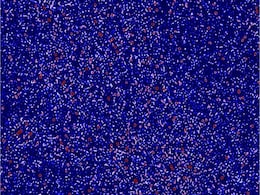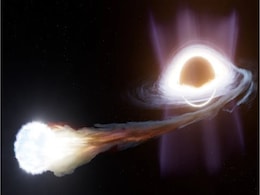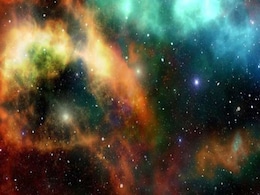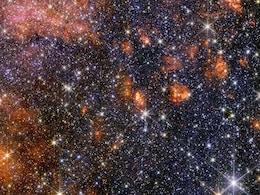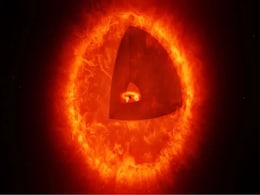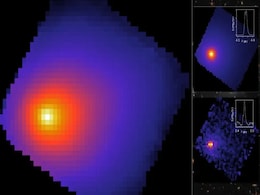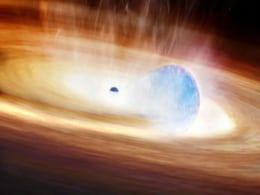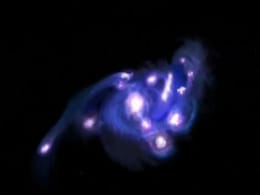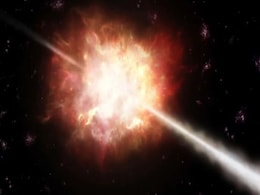Cosmic Observations
- All
- News
-

X-Ray Nebula Discovery Brings Astronomers Closer to Solving Cosmic Ray Mystery
- Friday November 28, 2025
- Written by Gadgets 360 Staff
A new study has linked an unexplained LHAASO detection to a pulsar-powered X-ray nebula, confirming it as a rare PeVatron capable of accelerating particles to extreme energies. The discovery is a major step toward solving the long-standing mystery of galactic cosmic rays. Researchers are now combining X-ray, gamma-ray and neutrino observations to t...
-
 www.gadgets360.com
www.gadgets360.com
-

James Webb Telescope May Have Discovered Universe’s Earliest Supermassive Black Hole
- Tuesday November 25, 2025
- Written by Gadgets 360 Staff
James Webb may have discovered the universe’s earliest supermassive black hole in galaxy GHZ2. Observations reveal high-energy emission lines, challenging existing models of rapid black hole and galaxy growth. Upcoming JWST and ALMA studies aim to confirm AGN activity and refine our understanding of early cosmic evolution.
-
 www.gadgets360.com
www.gadgets360.com
-

Mars Orbiter Tracks Interstellar Comet 3I/ATLAS With Unprecedented Precision
- Tuesday November 18, 2025
- Written by Gadgets 360 Staff
Scientists mapped the path of interstellar comet 3I/ATLAS with ten times greater accuracy using images from ESA’s Mars orbiter. The breakthrough shows how observations from different points in space can improve future planetary defense. The data, the first of its kind from another planet’s orbit, offers a powerful new tool for tracking fast-mov...
-
 www.gadgets360.com
www.gadgets360.com
-

James Webb Telescope May Have Spotted First Generation of Stars in the Universe
- Sunday November 16, 2025
- Written by Gadgets 360 Staff
Astronomers using JWST may have discovered Population III stars in cluster LAP1-B, offering new insights into early galaxy formation and the universe’s first luminous objects. JWST observations suggest Population III stars may have formed 13 billion years ago, helping trace early galaxies. These stars might be building blocks for larger galaxies ...
-
 www.gadgets360.com
www.gadgets360.com
-

Interstellar Visitor 3I/ATLAS Brightens Faster Than Expected, Surprising Scientists
- Tuesday November 4, 2025
- Written by Gadgets 360 Staff
The interstellar comet 3I/ATLAS has brightened far faster than expected during its solar approach, surprising researchers. Scientists say the unusual surge may point to rare chemical traits from another star system. Further observations in 2025 may reveal why this cosmic visitor behaves differently from typical comets in our solar neighbourhood.
-
 www.gadgets360.com
www.gadgets360.com
-

LIGO Detect Possible Second-Generation Black Holes with Extreme Spins
- Sunday November 2, 2025
- Written by Gadgets 360 Staff
LIGO-Virgo-KAGRA observatories detected two extraordinary black hole collisions in late 2024—GW241011 and GW241110. The first involved a rapidly spinning black hole, while the second revealed one rotating opposite its orbit. These findings fit predictions for second-generation black holes, born from earlier mergers within crowded star clusters. T...
-
 www.gadgets360.com
www.gadgets360.com
-

Scientists Create Most Detailed Radio Map of Early Universe Using MWA
- Saturday October 18, 2025
- Written by Gadgets 360 Staff
Scientists using the Murchison Widefield Array in Australia analyzed nine years of radio data to study the elusive 21-cm hydrogen signal from the universe’s dark ages. Their findings suggest early black holes and stars had already heated cosmic gas, marking the first observational evidence of this warming phase.
-
 www.gadgets360.com
www.gadgets360.com
-

Black Hole Tears Star Apart, Sends Out Powerful Flares Six Months Later
- Friday October 17, 2025
- Written by Gadgets 360 Staff
Astronomers detected a black hole 650 million light-years away devouring a star and then erupting twice with powerful flares months later. Observed by the Zwicky Transient Facility and tracked by ALMA and the VLA, this rare off-centre event hints at a rogue black hole cast out from its host galaxy.
-
 www.gadgets360.com
www.gadgets360.com
-

Pulsar Observations Could Reveal Gravitational Wave Interference From Black Holes
- Wednesday October 15, 2025
- Written by Gadgets 360 Staff
A new study proposes detecting gravitational-wave “beats” using pulsar timing. Researchers from Hirosaki University suggest that interference between waves from supermassive black hole binaries could appear as periodic variations in pulsar signals. The method may help distinguish individual sources from a diffuse gravitational-wave background i...
-
 www.gadgets360.com
www.gadgets360.com
-

James Webb Telescope Unveils Hidden Star-Forming Regions in Sagittarius B2
- Wednesday October 1, 2025
- Written by Gadgets 360 Staff
New JWST observations reveal the hidden star-forming activity inside Sagittarius B2, the Milky Way’s largest molecular cloud. By seeing through dense dust, astronomers can study how stars form efficiently in extreme environments. These findings help explain not only Sgr B2 but also broader mechanisms shaping galaxies.
-
 www.gadgets360.com
www.gadgets360.com
-

NASA’s James Webb Telescope May Have Found First Black Hole Star, Known as ‘The Cliff’
- Thursday September 25, 2025
- Written by Gadgets 360 Staff
JWST detected “The Cliff,” a candidate black hole star with a black hole core wrapped in a luminous gas shell. This discovery offers insights into black hole formation, stellar evolution, and cosmic dynamics, prompting astronomers to search for similar objects across the universe.
-
 www.gadgets360.com
www.gadgets360.com
-

James Webb Detects Carbon Dioxide–Dominated Coma in Interstellar Object 3I/ATLAS
- Wednesday August 27, 2025
- Written by Gadgets 360 Staff
The James Webb Space Telescope observed 3I/ATLAS, the third interstellar object detected in our solar system. Its coma is unusually rich in carbon dioxide with little water or carbon monoxide, suggesting a CO₂-rich core or an insulating crust. Findings raise new questions about its cosmic origin.
-
 www.gadgets360.com
www.gadgets360.com
-

Astronomers Observe Rare Supernova–Black Hole Interaction in Early Stages
- Sunday August 17, 2025
- Written by Gadgets 360 Staff
In a groundbreaking discovery, astronomers observed SN 2023zkd, a supernova that may have been triggered by close interaction with a black hole. Featuring unusual brightness peaks and extended pre-explosion activity, the event offers new insights into star black hole dynamics. Real-time AI detection played a key role, and upcoming surveys promise t...
-
 www.gadgets360.com
www.gadgets360.com
-

Astronomers Discover "Cosmic Grapes" Galaxy Packed with Star-Forming Clumps in the Early Universe
- Friday August 15, 2025
- Written by Gadgets 360 Staff
The "Cosmic Grapes" galaxy discovery sheds new light on early galaxy formation, revealing unexpected dense, star-forming clumps just 930 million years post-Big Bang. Uncovered through JWST, ALMA, and gravitational lensing, this breakthrough opens new opportunities for understanding the early cosmos.
-
 www.gadgets360.com
www.gadgets360.com
-

Brightest Gamma-Ray Burst Ever Observed Reveals Cosmic Secrets
- Friday August 1, 2025
- Written by Gadgets 360 Staff
On October 9, 2022, astronomers detected GRB 221009A, the most powerful gamma-ray burst ever recorded, earning the nickname “BOAT” (Brightest Of All Time). This rare, once-in-10,000-year event came from a galaxy 2 billion light-years away and temporarily blinded gamma-ray detectors. It revealed new insights into stellar death, as the associated...
-
 www.gadgets360.com
www.gadgets360.com
-

X-Ray Nebula Discovery Brings Astronomers Closer to Solving Cosmic Ray Mystery
- Friday November 28, 2025
- Written by Gadgets 360 Staff
A new study has linked an unexplained LHAASO detection to a pulsar-powered X-ray nebula, confirming it as a rare PeVatron capable of accelerating particles to extreme energies. The discovery is a major step toward solving the long-standing mystery of galactic cosmic rays. Researchers are now combining X-ray, gamma-ray and neutrino observations to t...
-
 www.gadgets360.com
www.gadgets360.com
-

James Webb Telescope May Have Discovered Universe’s Earliest Supermassive Black Hole
- Tuesday November 25, 2025
- Written by Gadgets 360 Staff
James Webb may have discovered the universe’s earliest supermassive black hole in galaxy GHZ2. Observations reveal high-energy emission lines, challenging existing models of rapid black hole and galaxy growth. Upcoming JWST and ALMA studies aim to confirm AGN activity and refine our understanding of early cosmic evolution.
-
 www.gadgets360.com
www.gadgets360.com
-

Mars Orbiter Tracks Interstellar Comet 3I/ATLAS With Unprecedented Precision
- Tuesday November 18, 2025
- Written by Gadgets 360 Staff
Scientists mapped the path of interstellar comet 3I/ATLAS with ten times greater accuracy using images from ESA’s Mars orbiter. The breakthrough shows how observations from different points in space can improve future planetary defense. The data, the first of its kind from another planet’s orbit, offers a powerful new tool for tracking fast-mov...
-
 www.gadgets360.com
www.gadgets360.com
-

James Webb Telescope May Have Spotted First Generation of Stars in the Universe
- Sunday November 16, 2025
- Written by Gadgets 360 Staff
Astronomers using JWST may have discovered Population III stars in cluster LAP1-B, offering new insights into early galaxy formation and the universe’s first luminous objects. JWST observations suggest Population III stars may have formed 13 billion years ago, helping trace early galaxies. These stars might be building blocks for larger galaxies ...
-
 www.gadgets360.com
www.gadgets360.com
-

Interstellar Visitor 3I/ATLAS Brightens Faster Than Expected, Surprising Scientists
- Tuesday November 4, 2025
- Written by Gadgets 360 Staff
The interstellar comet 3I/ATLAS has brightened far faster than expected during its solar approach, surprising researchers. Scientists say the unusual surge may point to rare chemical traits from another star system. Further observations in 2025 may reveal why this cosmic visitor behaves differently from typical comets in our solar neighbourhood.
-
 www.gadgets360.com
www.gadgets360.com
-

LIGO Detect Possible Second-Generation Black Holes with Extreme Spins
- Sunday November 2, 2025
- Written by Gadgets 360 Staff
LIGO-Virgo-KAGRA observatories detected two extraordinary black hole collisions in late 2024—GW241011 and GW241110. The first involved a rapidly spinning black hole, while the second revealed one rotating opposite its orbit. These findings fit predictions for second-generation black holes, born from earlier mergers within crowded star clusters. T...
-
 www.gadgets360.com
www.gadgets360.com
-

Scientists Create Most Detailed Radio Map of Early Universe Using MWA
- Saturday October 18, 2025
- Written by Gadgets 360 Staff
Scientists using the Murchison Widefield Array in Australia analyzed nine years of radio data to study the elusive 21-cm hydrogen signal from the universe’s dark ages. Their findings suggest early black holes and stars had already heated cosmic gas, marking the first observational evidence of this warming phase.
-
 www.gadgets360.com
www.gadgets360.com
-

Black Hole Tears Star Apart, Sends Out Powerful Flares Six Months Later
- Friday October 17, 2025
- Written by Gadgets 360 Staff
Astronomers detected a black hole 650 million light-years away devouring a star and then erupting twice with powerful flares months later. Observed by the Zwicky Transient Facility and tracked by ALMA and the VLA, this rare off-centre event hints at a rogue black hole cast out from its host galaxy.
-
 www.gadgets360.com
www.gadgets360.com
-

Pulsar Observations Could Reveal Gravitational Wave Interference From Black Holes
- Wednesday October 15, 2025
- Written by Gadgets 360 Staff
A new study proposes detecting gravitational-wave “beats” using pulsar timing. Researchers from Hirosaki University suggest that interference between waves from supermassive black hole binaries could appear as periodic variations in pulsar signals. The method may help distinguish individual sources from a diffuse gravitational-wave background i...
-
 www.gadgets360.com
www.gadgets360.com
-

James Webb Telescope Unveils Hidden Star-Forming Regions in Sagittarius B2
- Wednesday October 1, 2025
- Written by Gadgets 360 Staff
New JWST observations reveal the hidden star-forming activity inside Sagittarius B2, the Milky Way’s largest molecular cloud. By seeing through dense dust, astronomers can study how stars form efficiently in extreme environments. These findings help explain not only Sgr B2 but also broader mechanisms shaping galaxies.
-
 www.gadgets360.com
www.gadgets360.com
-

NASA’s James Webb Telescope May Have Found First Black Hole Star, Known as ‘The Cliff’
- Thursday September 25, 2025
- Written by Gadgets 360 Staff
JWST detected “The Cliff,” a candidate black hole star with a black hole core wrapped in a luminous gas shell. This discovery offers insights into black hole formation, stellar evolution, and cosmic dynamics, prompting astronomers to search for similar objects across the universe.
-
 www.gadgets360.com
www.gadgets360.com
-

James Webb Detects Carbon Dioxide–Dominated Coma in Interstellar Object 3I/ATLAS
- Wednesday August 27, 2025
- Written by Gadgets 360 Staff
The James Webb Space Telescope observed 3I/ATLAS, the third interstellar object detected in our solar system. Its coma is unusually rich in carbon dioxide with little water or carbon monoxide, suggesting a CO₂-rich core or an insulating crust. Findings raise new questions about its cosmic origin.
-
 www.gadgets360.com
www.gadgets360.com
-

Astronomers Observe Rare Supernova–Black Hole Interaction in Early Stages
- Sunday August 17, 2025
- Written by Gadgets 360 Staff
In a groundbreaking discovery, astronomers observed SN 2023zkd, a supernova that may have been triggered by close interaction with a black hole. Featuring unusual brightness peaks and extended pre-explosion activity, the event offers new insights into star black hole dynamics. Real-time AI detection played a key role, and upcoming surveys promise t...
-
 www.gadgets360.com
www.gadgets360.com
-

Astronomers Discover "Cosmic Grapes" Galaxy Packed with Star-Forming Clumps in the Early Universe
- Friday August 15, 2025
- Written by Gadgets 360 Staff
The "Cosmic Grapes" galaxy discovery sheds new light on early galaxy formation, revealing unexpected dense, star-forming clumps just 930 million years post-Big Bang. Uncovered through JWST, ALMA, and gravitational lensing, this breakthrough opens new opportunities for understanding the early cosmos.
-
 www.gadgets360.com
www.gadgets360.com
-

Brightest Gamma-Ray Burst Ever Observed Reveals Cosmic Secrets
- Friday August 1, 2025
- Written by Gadgets 360 Staff
On October 9, 2022, astronomers detected GRB 221009A, the most powerful gamma-ray burst ever recorded, earning the nickname “BOAT” (Brightest Of All Time). This rare, once-in-10,000-year event came from a galaxy 2 billion light-years away and temporarily blinded gamma-ray detectors. It revealed new insights into stellar death, as the associated...
-
 www.gadgets360.com
www.gadgets360.com







